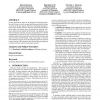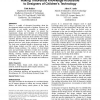327 search results - page 14 / 66 » How to Evaluate Social Intelligence Design |
ATAL
2010
Springer
13 years 9 months ago
2010
Springer
In many applications, tasks can be delegated to intelligent agents. In order to carry out a task, an agent should reason about what types of resources the task requires. However, ...
HRI
2011
ACM
13 years 2 days ago
2011
ACM
In this paper, we present a real world user study of 4 interfaces designed to teach new visual objects to a social robot. This study was designed as a robotic game in order to mai...
AAAI
2004
13 years 10 months ago
2004
We consider from a computational perspective the problem of how to aggregate the ranking preferences of a number of alternatives by a number of different voters into a single cons...
CHI
2011
ACM
13 years 5 days ago
2011
ACM
There is a wealth of theoretical knowledge about the developmental abilities and skills of children. However, this knowledge is not readily accessible to designers of interactive ...
ICMI
2009
Springer
13 years 6 months ago
2009
Springer
Affect sensitivity is of the utmost importance for a robot companion to be able to display socially intelligent behaviour, a key requirement for sustaining long-term interactions ...


